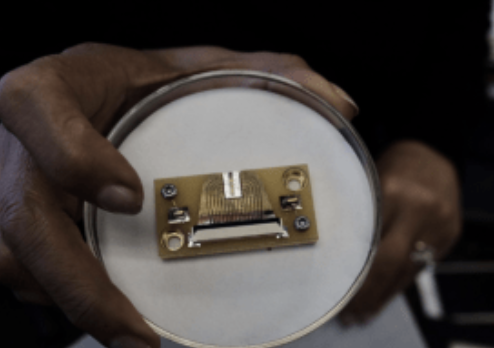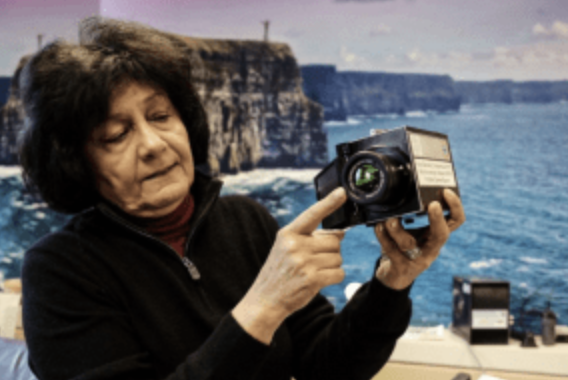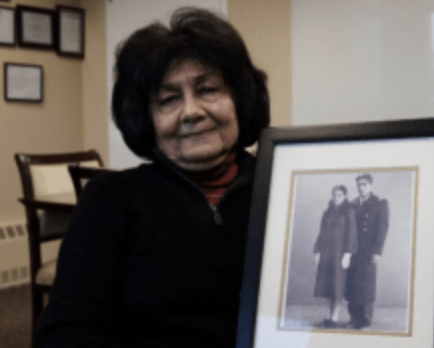Seeking Illumination
The tea offered by Manijeh Razeghi will go cold in my cup. Two sips is all I manage before setting it aside in her tastefully appointed office.
 Prof. Razeghi holds the world's first tiny array of tunable infrared lasers that she developed for Department of Homeland Security. A patent is pending for the device, which allows for molecular spectroscopy and is enabling a new generation of airport scanners.
Prof. Razeghi holds the world's first tiny array of tunable infrared lasers that she developed for Department of Homeland Security. A patent is pending for the device, which allows for molecular spectroscopy and is enabling a new generation of airport scanners.
The drink is fine, but very quickly I am caught up in Hurricane Razeghi: the force of nature, the high-energy gamma ray, the pioneering physicist, electrical engineer, and founder of Northwestern’s Center for Quantum Devices in Cook Hall on the Evanston campus.
“For me, the impossible is possible!” she says.
On the walls are numerous framed awards from a lifetime of scientific achievement. On her desk sit cutting-edge semiconductor devices; small, boxy lasers that resemble props from a sci-fi film. The gear is unique and has been designed, engineered, and tested by Razeghi’s lab, and it is revolutionizing communications, imaging, and national security. She currently has more than 60 patents and has generated new ways to create semiconductor materials and to design optoelectronic quantum devices.
“My father gave me the name Manijeh,” says the McCormick School of Engineering professor with obvious pride as she recalls her beloved parent, a pilot who pursued a maverick path against the wishes of a family full of teachers and physicians. “It means ‘the preferred child of a king.’”
From the start, Razeghi says her name made her “proud to be a woman,” even when other families may have been praying for sons. Education was the bedrock of her childhood, and she always knew she wanted “to learn and to help.” For a time, she considered a medical career, motivated partly by her father’s cigarette smoking and a fear of the cancer it might cause, but ultimately she found fundamental physics — and the elegance of the Periodic Table — more alluring, leading to a doctorate from the University of Paris.
“Everything is there in the Periodic Table. It is the secret to science,” says Razeghi, who received the 2018 Benjamin Franklin Institute Medal, a distinction putting her in the ranks of Nicola Tesla, Marie Curie, and Albert Einstein.
Still, it wasn’t enough to excel only in physics, she remembers. “You had to be good in everything; art, music, language.” Scholarship always represented a universal value and one Razeghi associates especially with women, since “they are responsible for bringing the child into this life and for educating them from the very first day,” she says. “One hand shakes the cradle and the other shakes the world!”
Razeghi certainly has transformed her world, and ours, harnessing the power of light to do extraordinary things.
Light Years: Three Decades Stalking the Spectrum
Razeghi’s breakthrough discovery in the 1980s was developing the metalorganic chemical vapor disposition (MOCVD) growth of a semiconductor called indium phosphide. MOCVD allows for precise layering of atoms onto a semiconductor wafer and allowed Razeghi to make the first commercial lasers for fiber-optic telecommunications. At the time she was hailed as “the Madonna of MOCVD,” not just for her lasers, but also for the new fundamental physics and quantum devices these semiconductor materials allowed.
The discovery made her reputation. “I could have gone anywhere! They all wanted me: Bell Labs, MIT, Stanford,” says Razeghi.
 Razeghi displays a high-operating temperature mid-wavelength infrared camera developed in her lab. The camera allows superior infrared imaging in a portable format valuable for a range of applications — from military and national defense use to medicine.
Razeghi displays a high-operating temperature mid-wavelength infrared camera developed in her lab. The camera allows superior infrared imaging in a portable format valuable for a range of applications — from military and national defense use to medicine.
Against all odds and after two years of recruitment, in 1991 Northwestern lured Razeghi away from the Thomson-CSF Exploratory Materials Lab in France, where she was working her MOCVD miracles. Razeghi chose Northwestern because then President Arnold Weber and McCormick School Dean Jerome Cohen promised her the opportunity to build her own unique facility to pursue groundbreaking science.
“It was a challenge to be ‘first and best,’ and I believe I did create something the equivalent of which never existed anywhere else,” she says, showing me a handwritten note from President Weber dated 1994: Two years later, you have kept all your promises and lifted our future aspirations. Formidable! The missive is part of a chorus of praise — from provosts, professors, Nobel laureates, military defense program managers, industry leaders — compiled in several volumes of scrap books spanning three decades. “Through the Center for Quantum Devices,” she says, “Northwestern is achieving results that are very, very difficult to achieve. No one comes close.”
Since joining the University, Razeghi’s research at the Center has advanced the frontiers of semiconductor science and nanotechnology, creating and using forms of light in the ultraviolet, infrared, and terahertz frequency range.
We use different light frequencies to transmit wireless data. Higher frequencies typically result in faster wireless data speeds, but the highest frequencies — gamma and X-rays — don’t travel easily through the atmosphere, plus they can harm human tissue through ionization. Existing slower radio and microwave frequencies are already used for communications. This led Razeghi to develop a way to exploit the terahertz section of the spectrum, a space between infrared and microwave radiation. In the beginning, generating these waves was difficult and required ultra-cold-temperature lasers. Using indium phosphide-based semiconductors, Razeghi discovered a way to create a room-temperature laser to make terahertz transmission practical for the first time. It is poised to enable superfast WiFi: a current German laser system based on her research already can transmit the equivalent of 13 high-definition feature films per second.
Significant aspects of her research have implications for the US government and Razeghi gratefully acknowledges the support and partnership from entities such as the Department of Defense, NASA, and the Department of Homeland Security. Modern airport scanners use technology based on Razeghi’s research, as do the lasers that carry the Internet under the sea. Other work includes new methods to improve infrared imaging as well as imaging breakthroughs that can detect weapons and explosives or provide noninvasive ways for art curators and scholars to study centuries-old paintings, and for bioscientists to see pathogens. Her terahertz research was the basis of her Franklin Institute Medal last year.
Illustrating her scientific contributions, to date, Razeghi has published more than a 1,000 papers, 19 books and 33 chapters, and made more than 1,000 conference presentations, lectures, and plenary talks. Her achievements gain additional luster when one learns Razeghi earned a bachelor’s degree in nuclear physics at Tehran University after being married at 15 and while raising three children. “Some of my teachers were crying! They thought I was not going to continue my studies after the wedding,” she says with a smile. “But I wanted to be independent and to see who I really was." Plus, I had the example of my parents’ [happy] relationship, and I was in love.”
 “My father gave me the name ‘Manijeh.’ It means the ‘preferred child of a king,'” says Razeghi, holding a portrait of her parents. She credits them with encouraging her talents and curiosity very early.
“My father gave me the name ‘Manijeh.’ It means the ‘preferred child of a king,'” says Razeghi, holding a portrait of her parents. She credits them with encouraging her talents and curiosity very early.
A Mentor with Global Impact
Razeghi takes her responsibilities as a teacher very seriously, too: She designed Northwestern's undergraduate and graduate programs in solid-state engineering and has shaped a generation of scientists who have themselves gone on to illustrious professional opportunities. In addition to the countless undergraduates who have learned from her, more than 60 doctoral and 20 master’s students have studied and worked with Razeghi.
In fact, her office is sprinkled with tokens of esteem from a legion of grateful former students whose careers in academia, industry, and government she helped launch. The shelves hold Razeghi’s seminal textbooks (including The MOCVD Challenge), conference proceedings, binders detailing highlights of her tenure, and beautiful photos of family, friends, and colleagues. For all her obvious self-confidence, Razeghi also repeatedly emphasizes the contributions of others, particularly her students, whom she extols as “only the very best anywhere.” Some of those former students, like Ryan McClintock, Steven Slivken, and Hooman Mohseni, are now themselves Northwestern faculty members.
Melding maternal affection and mentorship with ambition, Razeghi will frequently exhort her lab team: “Keep going! Go faster! Go, go, go!” This urgency stems from her passion for discovery, commitment to pushing interdisciplinary boundaries, and a belief that, through scientific study, the universe yields its secrets and that those secrets can help provide the tools to help and heal people. She also believes that the more one learns, the more there is to know.
“The atom once seemed so simple — the smallest part of a material,” she says. “Of course, high-energy physics has revealed that subatomic particles are actually very complex and there is always more to learn.”
This week in early February, Razeghi and members of her lab are headed to San Francisco where she will deliver a keynote talk and chair a conference on quantum sensing, nanoelectronics and photonics for SPIE’s annual marquee event that attracts nearly 20,000 industry and academic thought leaders. In addition, the SPIE fellow will chair a session dedicated to recognizing the achievements of younger scientists — the Early Career Innovation Awards in Quantum Sensing and Nano Elecronics and Photonics.
“I have a mission to teach, to train — not only others, but myself at the same time,” she says. “You have to have purpose in your life and be productive at whatever you do. At any stage you can have an impact, whether in science, or art, or music. Keeping human curiosity is the most important thing. I am always thinking ‘what’s next?’”